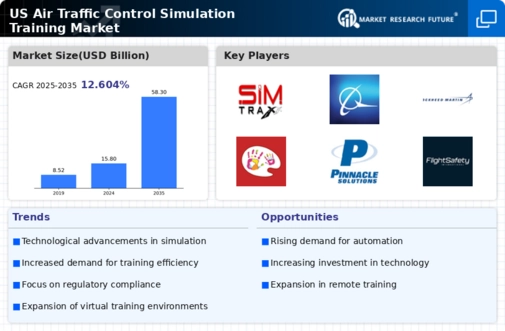Focus on Safety and Risk Management
Safety and risk management remain at the forefront of the aviation industry, significantly influencing the air traffic-control-simulation-training market. Regulatory bodies, including the FAA, emphasize the importance of rigorous training standards to mitigate risks associated with air traffic management. As a result, training programs are increasingly incorporating risk assessment and management strategies into their curricula. This focus on safety is likely to drive demand for simulation training, as it provides a controlled environment for trainees to practice handling emergencies and high-pressure situations. The air traffic control simulation training market is expected to expand as institutions prioritize safety in their training methodologies.
Integration of Advanced Technologies
The integration of advanced technologies into the air traffic-control-simulation-training market is transforming the landscape of training methodologies. Innovations such as virtual reality (VR) and artificial intelligence (AI) are being increasingly adopted to create immersive training environments. These technologies allow trainees to experience realistic scenarios, enhancing their decision-making skills and situational awareness. The FAA has recognized the potential of these technologies, indicating that they could improve training efficiency by up to 25%. As training providers invest in these advanced tools, the air traffic-control-simulation-training market is likely to see significant growth, driven by the demand for more effective training solutions.
Collaboration with Technology Providers
Collaboration between training institutions and technology providers is emerging as a vital driver in the air traffic-control-simulation-training market. Partnerships with tech companies enable training organizations to access cutting-edge simulation tools and resources, enhancing the quality of training programs. These collaborations often lead to the development of customized training solutions that meet specific regulatory requirements and industry standards. As the aviation sector evolves, such partnerships are likely to become more prevalent, fostering innovation in training methodologies. The air traffic control simulation training market is likely to grow as these collaborations enhance the effectiveness and relevance of training offerings.
Growing Demand for Air Traffic Controllers
The air traffic-control-simulation-training market is experiencing a notable increase in demand for qualified air traffic controllers. As air travel continues to expand, the need for skilled professionals to manage air traffic safely and efficiently becomes paramount. According to the Federal Aviation Administration (FAA), the number of commercial flights is projected to rise by approximately 30% over the next decade. This surge necessitates enhanced training programs, leading to a greater reliance on simulation training. The air traffic control simulation training market is positioned to benefit from this growing demand as training institutions seek to equip new controllers with the necessary skills to handle increased air traffic volumes.
Increased Investment in Aviation Infrastructure
Investment in aviation infrastructure is a critical driver for the air traffic-control-simulation-training market. The U.S. government has allocated substantial funding for the modernization of air traffic control systems, with an estimated $30 billion earmarked for upgrades over the next five years. This investment not only enhances the safety and efficiency of air travel but also necessitates the training of personnel on new systems and technologies. Consequently, training programs must adapt to these changes, leading to an increased demand for simulation training. The air traffic-control-simulation-training market stands to gain from this trend as training providers align their offerings with the evolving needs of the aviation sector.





















Leave a Comment